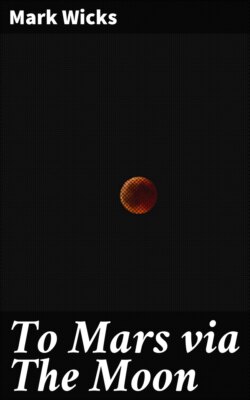Читать книгу To Mars via The Moon - Mark Wicks - Страница 19
THE SCENERY OF THE MOON'S SOUTHERN HEMISPHERE
ОглавлениеI now directed M'Allister to steer across the lunar equator into the southern hemisphere, and our attention was soon attracted by a very large walled plain on the eastward side of our course.
John asked me what it was called, and I explained that it was named Grimaldi, being also well known to observers as the darkest tinted of all the large lunar formations. As seen from the earth it appears a narrow ellipse, but we could see its full width, which is 129 miles, the length being 148 miles. It is also noteworthy as one of the few plains which are convex in section, and it is so large that its area is equal to the combined area of the whole of the counties of England south of the line of the Thames, including Cornwall.
I showed M'Allister this formation on our map, where it appears only a narrow ellipse in consequence of the moon's curvature, and pointed out how very different was its appearance now we could see over its whole extent. Other formations nearer to the moon's limb appear still more foreshortened when viewed from the earth.
John here remarked that "these large ring-plains covered immense areas, and, now that we could actually see them, their magnitude was more impressive than anything we could have imagined from merely hearing or reading about them."
"Yes, John," I said, "from our altitude of more than ten miles above the lunar surface we command a much more extensive view and gain a better knowledge of details than we could obtain even if we landed on the moon. For instance, if we could stand down in the centre of one of those very large rings, we should imagine we were in the midst of a boundless open plain. The mountains all around us would be so distant that, owing to the sharp curvature of the lunar sphere, they would all be below the horizon, notwithstanding the fact that many of them are several thousands of feet in height. So, for all we could see of them, those mountains might be non-existent.
"In the case of somewhat smaller rings we might perhaps see, here and there above the horizon, just the topmost peaks of some of the more lofty mountains."
M'Allister was now struck with an idea, and exclaimed, "Professor, I notice that many of these great walled plains are very flat, and I should think they would make fine golf-links, for there would be plenty of room to send the ball flying!"
"Undoubtedly," I answered, "you would have plenty of space for that; and I can tell you that you would be able to send the ball flying six times as far as you could on the earth with the same expenditure of force, because the moon's gravitation is only one-sixth of that of the earth."
"That would be grand," said M'Allister. "I should like to have a few turns at golf on the moon."
"Ah, but you would also have extra long tramps after your ball," I told him, "so you would get plenty of exercise; but, for the reason already mentioned, you would be able to get over the ground six times as easily."
"Well, Professor, I should not mind the distance in those circumstances," he answered jauntily.
"Perhaps you like jumping exercise too," I said. "Only fancy, M'Allister, if you wanted to jump across one of those narrower cracks! Why, if you could jump a distance of ten feet on the earth, you could jump sixty feet on the moon just as easily! Some of our athletes have jumped a length of twenty-six feet, so the same persons could with equal ease jump 156 feet on the moon! What do you think of that for a long jump?"
"Heh, Professor," he replied, looking rather bewildered, "what a jump! Why, I should think the mon was never coming down again!"
"I say, though, M'Allister, after all I am inclined to think you would not find golf on the moon altogether a pleasant game," said John.
"Why not, mon?" inquired M'Allister.
"Well," answered John, "I was thinking that if you sent your ball flying into one of those cracks which are several miles deep you would find yourself eternally 'bunkered,' for no niblick ever made would get you out of that."
M'Allister laughed so heartily at this idea of John's that we both joined in his mirth; then I recommended him to wait until we reached Mars if he wished to enjoy a game of golf, for there he would be sure to find enormous stretches of level ground.
